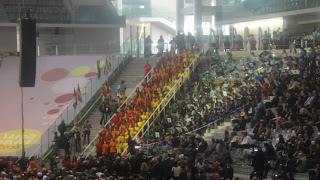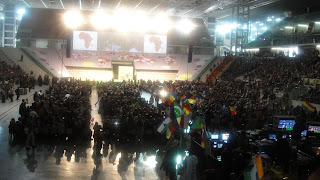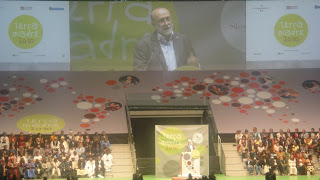Terra Madre ran parallel to the Salone del Gusto. Terra Madre is a place where people from all over the world who are concerned with the future in terms of sustainable food production that works within the respect of the environment and for the people. These farmers and producers are united with the consumers and food activists who revolutionize the way the world grows, makes, sells and eats. There were workshops throughout the weekend, rooms to learn about Slow Food Presidia and Projects as well as space for people to sell and share their products. Mats were laid out in rows and all sorts of things were for sale - woven bags, oils, spices in plastic bags, educational posters, jewelry, t-shirt's, patterned clothes, shoes, scarves, a man from Japan weaving flip flops from straw next to a Kenya man not wearing any shoes selling leather bags. There were fruits too that I have no idea how they got through customs. It was really nice to see these products, handmade or not, from all over the world, from places many people will never have a chance to visit, but some of them were selling things as though it were a flea market (random pairs of high heels that could have come from any second hand store) and trying to bargain with the on-looker, offering prices while other products seemed extremely overpriced. Correct me if I'm wrong, but I thought the unification of people here was to share ideas and experiences, trade production methods and techniques, and to meet people to understand their different cultures and preserve native traditions, not to feel pressured into buying something. I don't know...
The first day was dedicated to critical issues concerning the planet and it's biodiversity. I attended one called Identity and Globalization of Biodiversity. It's focus was looking at how identities are connected with traditions and cultures and understanding what systems are in place for the local/regional to identify with the global community. The most interesting speech was from Logan Smith and Carissa Carmen - two Americans who have been working on Mary Mattingly's Waterpod Project. I'm not exactly sure how it fit into the subject of the workshop, but I found the analogy of their project to relate perfectly to the future of the world. The project is described as a four room village on a barge that floats around the 5 boroughs of NYC. It is not only a sustainable living space or a cultural museum, but it is an artistic vision where science and art merge to engage people towards a vision of the future. Volunteers came together to help because they believed in the same future. Logan and Carissa said that they weren't exactly sure what background experience they could offer, but it was more than just what they knew, it was about collaboration, requiring expertise and partnership to build an autonomous network. Everyone offered what they could, bringing in all sorts of disciplines, backgrounds, and experiences. It was about being an exchange of diversity that could appeal to all, using food as a common language, and to keep it public so that other people can learn and in turn, make their own projects better. If everyone contributes what they can and can work together, the goal can be accomplished. Think big, think impossible, and make it work. It seemed to be an overall idealistic theme/metaphor for the overall weekend of Terra Madre.
 |
| African fruit for sale? |
Then there were regional meetings where conviviums from certain countries or areas could get together to discuss what they've been doing for Slow Food, explain problems, share experiences, swap ideas, possible networking, and an overall feeling of togetherness. I attended one on Ireland (next post). There were also Earth Workshops focused on various sustainable agricultural themes. We each were assigned to attend one and to write a report about for the website. Mine, about Slow Food Education Principles. I also attended one called Honey & the Bees, Less Meat, Better Meat, and tried unsuccessfully to find one called Native Wools (no link, no report. cough cough).
 |
| Slow Food Presidiums around the world. |
















































